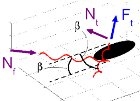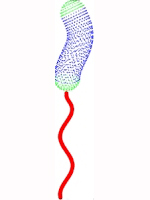
The wiggling trajectories of bacteria
The wobbling of cell bodies has often been observed and noted while flagellated bacteria swim. A wobbling cell body corresponds to a helical swimming trajectory. For a rigid flagellar bundle attached with a fixed orientation relative to the cell body, a helical trajectory is the natural result of off-axis thrust leading to simultaneous rotation and translation. Collaborators Marcos and Roman Stocker (MIT) observed helical trajectories of B. subtilisbacteria, and we calculated the trajectories resulting from a full range of orientations of a single flagellar bundle. We find that a single bundle is unlikely to produce helical trajectories with helical pitch greater than 4 μm. However, the many observed trajectories with pitch greater than 4 μm can be produced by B. subtilis swimming with multiple flagellar bundles.
(Published in J. Fluid Mechanics [pdf]) [Funded by NSF CBET-0967510 and CBET-1067798]
Top right image caption: A wiggling trajectory arises from an off-axis flagellar bundle causing simultaneous rotation and translation. Second and third image captions: Wiggling trajectories were calculated for bacteria with one and two flagellar bundles.
We find that a single bundle is unlikely to produce helical trajectories with helical pitch greater than 4 μm. However, the many observed trajectories with pitch greater than 4 μm can be produced by B. subtilis swimming with multiple flagellar bundles.
(Published in J. Fluid Mechanics [pdf]) [Funded by NSF CBET-0967510 and CBET-1067798]
Top right image caption: A wiggling trajectory arises from an off-axis flagellar bundle causing simultaneous rotation and translation. Second and third image captions: Wiggling trajectories were calculated for bacteria with one and two flagellar bundles.

How much does cell-body shape contribute to propulsion?
Helicobacter pylori bacteria can infect the stomach, and have been implicated in stomach ulcers and cancer. Although like many other bacteria they swim by rotating helical flagella, Helicobacter also have helical cell bodies, leading many to suggest that the counter-rotation of the cell body aids propulsion. We calculate the effect of cell body shape on swimming velocities, and find that most of the effect on swimming is not due to cell-body thrust, but rather due to changes in drag. Via a collaboration with Rama Bansil’s group at Boston University, we can compare our results to detailed measurements of swimming trajectories. Since the helical cell body is likely one of the best shapes for additional propulsion, our results suggest that other cell-bodies likely do not have large contributions to thrust either.
Image caption: How much thrust is produced by the helical cell body of H pylori, and what is its effect on swimming speeds?


